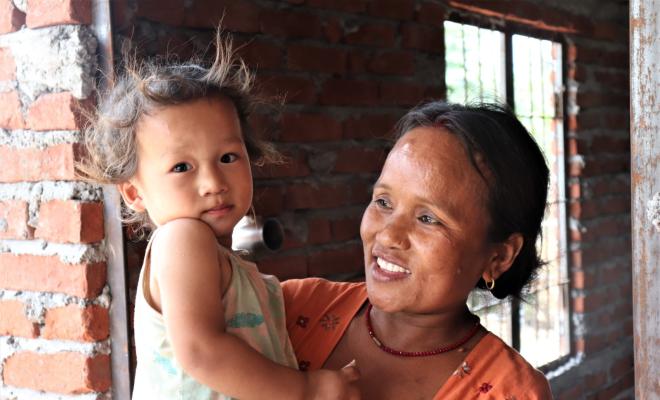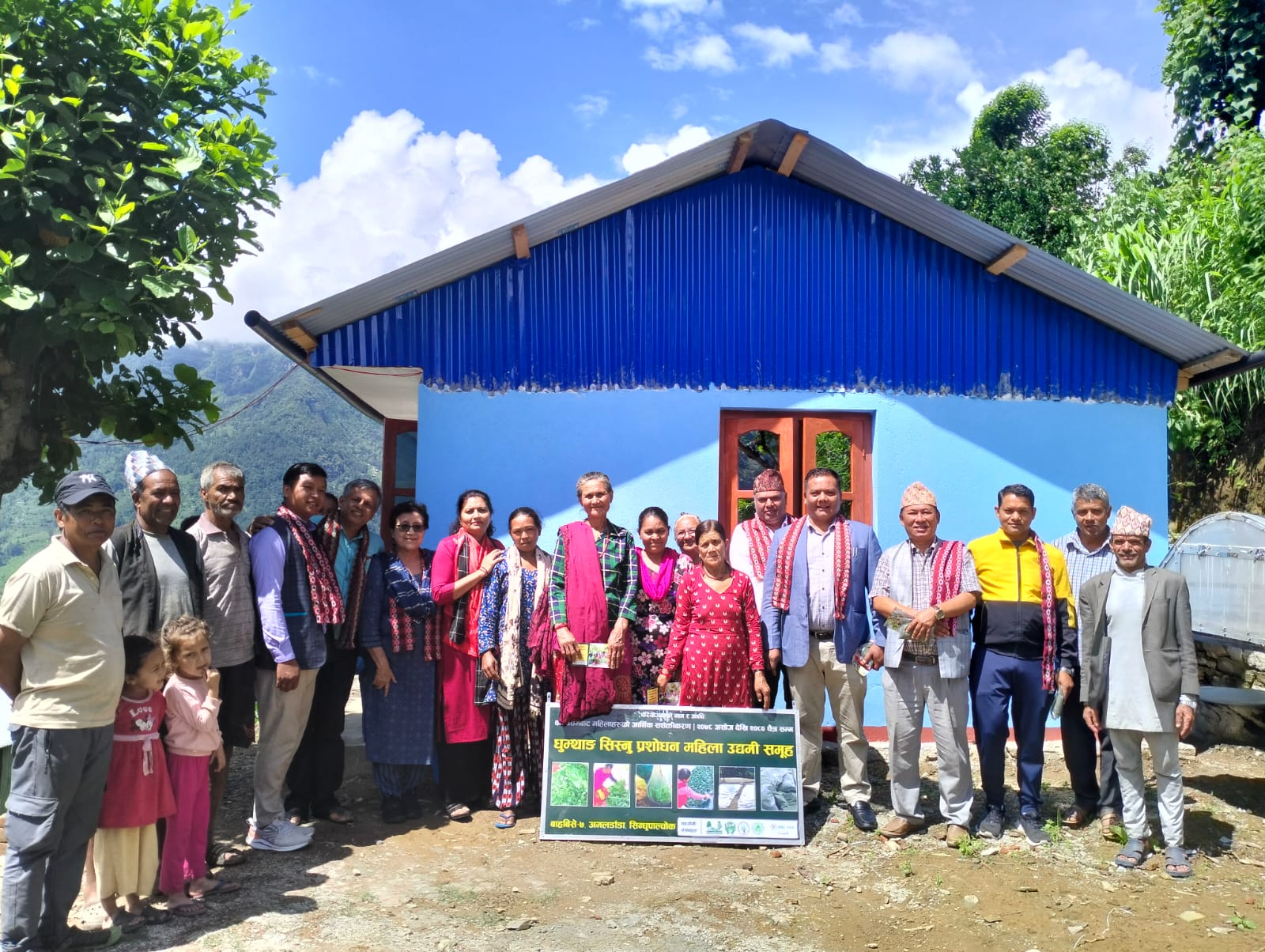Seeing construction through women’s eyes: as a cradle for socio-economic resilience

The trend of constructing gender-friendly infrastructure is systematically ignored in Nepal and elsewhere. Although the government issues a circular to strictly enforce building codes to ensure disabled-friendly infrastructure construction, the practice does not materialise. Yet, mainstreaming women’s needs and accommodating diverse people’s perspectives into infrastructure design has the power to address gender inequalities and increase women’s mobility. It can also link with to efforts to enhance women’s access to and ownership of land, where a great gender gap exists.
In this context, the GLOW project Economic Empowerment of Women through Forest Solutions (WEE-FS) is addressing the vital issue of infrastructure development in sustaining women-led micro enterprises in Nepal. The project has secured six collective spaces for more than 240 women, engaging in 18 enterprise groups from the rural areas of Nawalpur and Sindhupalchok. These six “women entrepreneurs’ homes” were constructed to offer collective working spaces and solve the women’s difficulty in finding workspaces elsewhere.
In Bhujel village, Nawalparasi, where the project has supported bamboo enterprises, the women entrepreneurs wanted to use bamboo-splitting technology to enhance the efficiency of their production. The WEE-FS project supported them to purchase the required machine. However, the women struggled to find an appropriate place to install it. They asked the WEE-FS project to support construction of a building where they could use the machine together.
The women identified land for construction; but a powerful man sought to undermine them. Initially, he pretended to support the women’s group by providing a land lease agreement for 20 years (claiming that he owned the land, although it was never formally registered to him). The women suspected foul play and refused to accept.
He then led a small group of men in threatening the women to dispose of all the project’s capital equipment, if interrogated further on the land issue. In defence, the women are now claiming their rights with the local government and community forest user group (CFUG) - asking them to grant a plot of land for women's enterprise buildings.
Completely different women’s groups in Sindhupalchok requested a solar dryer and grinding machine to expand their processing of nettle powder and cardamom, but could find no common space to install the machines. They started looking for rental space, but most requests were denied.
One man offered his land for a 20-year lease, the first two years free of cost. The women’s groups received equipment from the project, and started generating income. Then, the landlord began bargaining for rent and he threatened to throw out the machines if he did not receive it.
In another case, the women entrepreneurs running bio-cup and bio-plate businesses had to transfer their equipment from one place to another, paying the charges from their own pockets. There was a shortage of common space for the meetings and other capacity-building programmes. At times, CFUG events would clash with entrepreneurs' machine operations, training programmes, or other group activities.
These examples illustrate how women entrepreneurs feel insecure due to lack of space for their enterprises. To meet these multiple needs, the women entrepreneurs decided to muster forces and pull together the legal permissions, materials, the labour and operating rules to construct and run a collective space, together with financial support from the project, local government and CFUGs.

The women’s group also managed to leverage timber from the CFUG and cash from the local government. This paved the way for mainstreaming the women’s voices and wishes into the ward level development plans. They reflected that, “we could never go to the local government and demand before, but now we can get budget for construction”. This proactive involvement of government authorities and supporting agencies is imperative for the viability and sustainability of such green enterprises. They hold the potential to boost household economies, ensure societal well-being, and encourage wise resource utilisation while lowering carbon damage.
The women took the lead in the construction work by breaking all the gender stereotypes. Formation of a construction committee, opening bank account, dealing with the contractors and bargaining with the hardware shopkeepers for the best price were all done by women.
After the establishment of the entrepreneurial buildings, the happiness of these entrepreneurs knew no bounds. “I’m proud of our engagement in the construction, my learning with this construction is more than what we I could gain while I was an elected representative in the local government”, said one entrepreneur.
The businesswomen from Bhagar, Gaidakot ward 14, are excited to have their own space. One of them shared, “Earlier, we had no common places for the machine installation, and it was so worrisome to carry the machine here and there in search of a common space. But now we have our own building”. Another entrepreneur added, “We had to pay the rent, but now we are rent-free as we have constructed our own building”.
A woman from a broom-making enterprise shared her excitement: “Finally, we have a space that we can freely call our own. Now we don’t have to wander here and there to search for a rental home for working on our enterprise activities and storage for our raw materials.”

A space free from violence and trauma
More importantly the “homes” have become a common ground to share the history-long oppressions of gender inequality and countless incidences of gender-based violence and intergenerational traumas. One of the entrepreneurs said that the house can act as a safe shelter for women suffering from domestic violence. She added, ”If there are any disputes in the family, at least I have a new safe home to stay in. This building has been a space to gain mental peace too and this makes me feel empowered.”
The community halls will hold the discussion, sharing, and interactions that help women to socialise and learn, while combating their loneliness through “women for women” counselling and support.
Space to keep materials, machinery and products safe from harm
Where there is economically valuable equipment, there will be security concerns, and the homes provide security from thefts. During disasters, they can be used as rescue homes; also as isolation centers during medical emergencies. In addition, the homes provide safe storage and can save the products from insect attacks and forest fires, too. Entrepreneurs noted that “we encountered losses as our bio-cups and plates were eaten by insects and mice! Now we are happy our products are safe in the newly constructed building”. Furthermore, the homes help to maintain hygiene when storing edible products such as sisnoo, lapsi, and triphala, which could be easily spoiled under poor storage conditions.
Space for innovation and creation
This space enhances creativity and innovation through the interactions among the entrepreneurs. “The home has helped us to maintain consistency in our products, the bags and mats that we prepare were not consistent in size and shape, but now we can work together”, said a Thakal entrepreneur. These common roofs weave the unity needed to empower marginalised women and people with disabilities to be part of societal and economic development through enterprise development. The women are creating ideas to diversify their products and exchange them with other entrepreneurs.
Space for meetings and cultural exchange
The homes act as the unifying places for the networking of different stakeholders, such as government line agencies, researchers, and other diverse visitors, with women entrepreneurs. They provide a common roof and ground for negotiations, capacity-building training, and marketing that will further enhance connectedness and cohesion. “After the machine and the products are safely stored and the decorated here in the entrepreneurs building, there has been an increase in the number of visitors to see the buildings and the process of bio-cup and plate production”, said an entrepreneur in Sankhadevi CFUG. The group has been motivating others to bring the lapha (leaves weaved together) or leaves with them so that we can buy them and they can reap the benefits as well as visit our enterprises too.
There are numerous women's festivals and social gatherings, and these buildings can be used as a common ground and recreational space for cultural exchange, uniting the diversity of entrepreneurs having different cultures and religions. They help create a friendly environment, where people can strengthen their social bonds, and celebrate peace and harmony.
Summary: one space, many benefits
There is true inclusion because each building comprises three rooms: one for productive machinery, storing raw materials, and showcasing the final products, a second room is for childcare and breast feeding and a third room is a kitchen where the women can cook snacks and eat. The building is not only gender-responsive, but also disability-friendly, being wheelchair-compatible.
This infrastructure is not just grey cement and concrete but rather signifies the roof of unity, agency and feminist compassionate leadership development. It also complies with SDG 9, Building resilient infrastructure by promoting inclusive and sustainable industrialization and fostering innovation.
This advancement of gender-responsive buildings that are safe, affordable, and reliable has significant potential for reducing the barriers that hold back the success of women entrepreneurs. Investing in more sustainable infrastructure and promoting gender equality are development priorities of Agenda 2030. These buildings have incorporated the multiple facets of women's entrepreneurial journey. They are a foundation that will carry the legacy of women's entrepreneurship, by maintaining sustainability and cohesion with other development actions.

